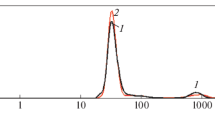Summary
Copoly(styrene/acrylonitrile) samples (S/AN) have been repeatedly separated according to composition by gradient HPLC with alkane hydrocarbons as a starting eluent A and dichloromethane (DCM) or tetrahydrofuran (THF) as a solvent B. In these systems, retention increased with AN content of the copolymers. The chemical nature of the column packings used had almost no influence on the retention of S/AN samples. The present paper shows thatn-pentane andn-heptane, when used in a given volumetric gradient with DCM+20% methanol as a solvent B, lead to identical solution characteristics of S/AN on silica columns. A similar result was obtained on C18 columns withn-heptane or cyclohexane, whereas gradient elution with toluene as a starting eluent caused insufficient resolution. Reversed phase separation of S/AN copolymers could be achieved on polystyrene gel columns through gradients with methanol as a starting eluent and DCM or THF as a solvent B. In both systems, retention decreased with increasing AN content of the copolymers. The elution characteristics were almost linear in the range 0–20 wt% AN. This behaviour can be understood in the context of polymer solubility: in both systems, the solubility borderline of S/AN has a distinct maximum at about 25 wt% AN. Reversed phase separation was achieved at the lefthand slope of these curves where the dissolution of a sample with a higher AN content requires less DCM or THF solvent than the dissolution of copolymers which are poorer in AN. This idea predicts that samples with more than 25 wt% AN should elute later than S/AN whose composition is near to the solubility maximum. This indeed was found with a copolymer containing 36.2 wt% AN.
Similar content being viewed by others
References
M. Danielewicz, M. Kubin, S. Vozka, J. appl. Polym. Sci.27, 3629 (1982).
G. Glöckner, H. Kroschwitz, Ch. Meißner, Acta Polymerica33, 614 (1982).
G. Glöckner, Pure & Appl. Chem.55, 1553 (1983).
G. Glöckner, J. H. M. van den Berg, N. L. J. Meijerink, Th. G. Scholte, R. Koningsveld, Macromolecules17, 962 (1984).
G. Glöckner, J. H. M. van den Berg, Chromatographia19, 55 (1984).
G. Glöckner, J. H. M. van den Berg, J. Chromatogr.384, 135 (1987).
R. Schultz, Thesis, Saarbrücken 1989, Chapt. F.
G. Glöckner, J. Chromatogr.403, 280 (1987).
S. Teramachi, A. Hasegawa, K. Motoyama, Polym. Prepr. Japan (Engl. Edition)36, E441, 3169 (1987).
R. W. Sparidans, II, A. Claessens, G. H. J. van Doremaele, A. M. van Herk, J. Chromatogr.508, 319 (1990).
M. Augenstein, personal commun. (1990).
G. Glöckner, J. Appl. Polym. Sci., Applied Polym. Symp.43, 39 (1989).
G. Glöckner, F. Francuskiewicz, K.-D. Müller, Plaste und Kautschuk18, 654 (1971).
Author information
Authors and Affiliations
Rights and permissions
About this article
Cite this article
Glöckner, G., Wolf, D. & Engelhardt, H. Separation of copoly(styrene/acrylonitrile) samples according to composition under reversed phase conditions. Chromatographia 32, 107–112 (1991). https://doi.org/10.1007/BF02325011
Received:
Accepted:
Published:
Issue Date:
DOI: https://doi.org/10.1007/BF02325011




